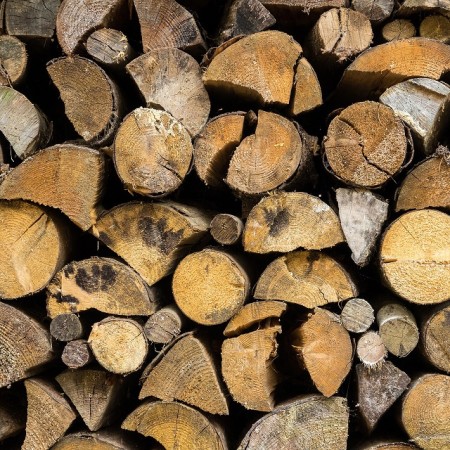It’s good to know how important it is to you and the environment that you light a fire in a wood-burning stove correctly. The German Technologie- und Förderzentrum (TFZ), which is an institution under the Ministry of Food, Agriculture and Forestry in Bavaria, has conducted a series of tests on:
- Firewood efficiency at different moisture content levels
- The level of particle emissions when lighting fires with firewood with varying moisture content.
The tests have been conducted in both stoves and wood-burning stoves and the results are unambiguous:
To get the best result with your wood burning stove, you should always…
- Light a fire using dry firewood with a moisture content below 18 %.
- Use logs that have been cut and split into appropriate size and length.
TIP: Chop your firewood so each log has approximately the same size as a standard bottle of wine.
Read more about TFZ’s scientific tests below:
The moisture content in your firewood must not be above 18 %
In this test, the lab has fired with wood with different moisture content percentages. They fired with wood which had a moisture content of 12 %, 18 %, 23 % and 30 %.
The test has been done in a stove.
Fuel: Beech. Length of logs: 33 centimetres.
Result:
You should always fire with wood which has a moisture content below 18% if you want to obtain the highest efficiency. As soon as the wood’s moisture content exceeds 18 %, the particle emissions increase drastically.
Further reading: Efficiency – make the most of your firewood
Moist firewood reduces the efficiency of firewood and the wood burning stove
This test was made in a wood burning stove. Amount of firewood: 1.4 kilograms. Water content: 12%, 20% og 30%.
Fuel: Beech. Length of logs: 25 centimetres.

The table shows how the efficiency of firewood and wood burning stoves is reduced when the firewood is moist
Result:
The higher the firewood’s moisture content is, the lower the efficiency will be. When firing with firewood with a moisture content of 30 %, the efficiency will be almost halved in comparison to the efficiency you can expect of a new wood burning stove. The optimal efficiency in a new wood burning stove is between 75-80 %. Furtheremore, the environmental impact increases considerably as soon as the moisture content in the firewood exceeds 18%.
Think about the environment – always light a fire using dry firewood
The graph shows how pollution increases in line with the moisture content. An increase in moisture content from 18 % to 25% pollutes five times as much.
The test was done in a wood burning stove. Fuel: 7×7 centimetres beech wood.
The graph below clearly shows that the particle emissions increase if you fire with firewood which has a high moisture content.
Use logs which have an appropriate size
– and make the most of your money
This test shows how much the size of the logs matters when it comes to your wood burning stove’s efficiency which is it’s ability to exploit the firewood as much as possible to create heat.
The test was done in a stove. Fuel: Beech wood. The length of the logs: 33 centimetres. Fuel load: 4.5 kilogram.

The size of the logs matters if you want the optimal efficiency for you wood burning stove and complete combustion
Result:
If the logs you use to fire with are too big, you’ll reduce the efficiency while logs too small can damage the environment.
Read more about the size of the logs and which impact the size has on particle and carbon dioxide emissions below.
In this test, they fired five times with 2.5 kilogram of firewood with logs of varying sizes.
The test was made in a wood burning stove. Fuel: Beech wood without bark. Fuel load: 2.5 kilograms. Moisture content: 15.5 %.
Result:
The test shows that the most ideal log size is 7x7x25 centimetres if you want to minimise the particle and carbon dixode emissions during combustion.
Cause:
If you use logs that are too small, you won’t get complete combustion. That’s because there won’t be enough oxygen to burn the gases which the firewood releases. The pollution happens when the gases disappear up the chimney as smoke instead of being transformed into heat in your house.
If you fire with logs that are too big, you’ll risk that the temperature in the stove will be too low.
Use neither too little nor too much firewood
This test was done to establish how big the amount of firewood should be when firing in order to minimise particle and carbon dioxide emissions.
The test was done in a wood burning stove. Fuel: Beech wood without bark. The size of the logs: 5x5x25 (the amount of logs is increased for each test). The moisture content: about 14 %.
Result:
The graph shows that the lowest particle and carbon dioxide emissions happen when the amount of firewood is 0.92 til 1.75 kilogram per firing.
The graph also shows that you should be careful not to put neither too much nor too little firewood in your wood burning stove when you fire.
Both the smallest amount of 0.45 kilogram per firing and the biggest amount of 2.30 kilogram per firing pollute more than the recommended amount of 0.92 to 1.75 kilogram per firing.
You can find more information on the TFZ tests here
*Source: The graphs in this article come from TFZ-Bericht no. 36. og 22:
Ellner-Schuberth, F.; Hartmann, H.; Turowski, P.; Roßmann, P. (2010): Partikelemissionen aus Kleinfeuerungen für Holz und Ansätze für Minderungsmaßnahmen. Berichte aus dem TFZ, Nr. 22. Straubing: Technologie- und Förderzentrum im Kompetenzzentrum für Nachwachsende Rohstoffe (TFZ), 135 Seiten, ISBN 1614-1008
Schön, C.; Hartmann, H. (2014): Nutzer- und Brennstoffeinflüsse auf Feinstaubemissionen aus Kleinfeuerungsanlagen. Berichte aus dem TFZ, Nr. 36. Straubing: Technologie- und Förderzentrum im Kompetenzzentrum für Nachwachsende Rohstoffe (TFZ), 173 Seiten, ISSN 1614-1008










